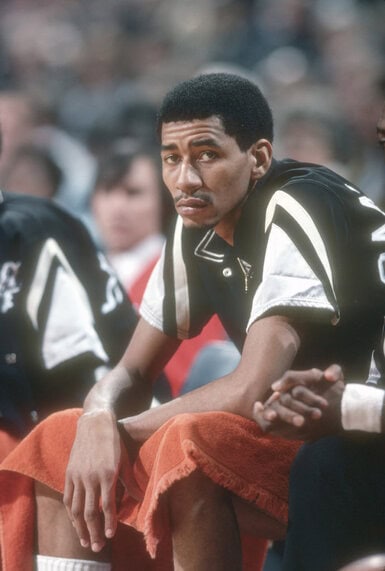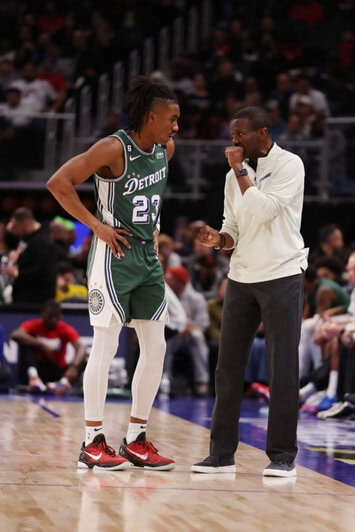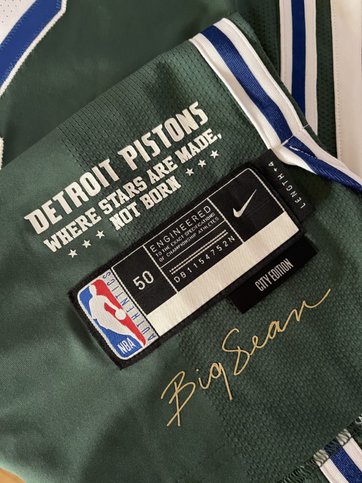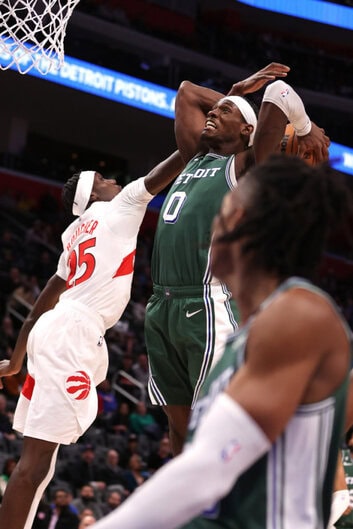Big Sean, Nike & the Detroit Pistons dug deep to tell tales of St. Cecilia’s: the most storied summer run in Motor City hoops history.
Last week, the Detroit Pistons traveled to New York to face the Knicks on Kith Night — a coronation for the Knicks’ first-ever creative director, Ronnie Fieg.
Madison Square Garden hosted the likes of Fat Joe and Fabolous, who sat courtside in support of Fieg as the home team took the court in their new black-based City Uniforms, made in collaboration with Kith and Nike.
Detroit and New York, two cities where basketball lives in the DNA of its people, have long histories on the court. Many have heard tell of the battles at the intersection of 33rd Street and Eighth Ave, or when the Bad Boys patrolled the Palace of Auburn Hills.
Less known, however, is what went on in the cramped corridors of St. Cecilia’s Church.
“New York brought a team in to play the best of Detroit in the summer of 1974,” Greg Kelser, Pistons announcer and former No. 4 Pick, told Boardroom. “Bernard King, who went on to become a Hall of Famer, was part of that New York team.”
Kelser, a Detroit native who won a National Championship at Michigan State and later played for the Pistons, spent much of his high school, college, and pro summers at St. Cecilia’s gym.
While big names on the sideline often overshadow the zeal on the court in major markets, the energy was different in those summer runs at a church in Motown that spanned the ’70s, ’80s, and ’90s.
“Fans used to fill the place,” Kelser says.
“Pros like George Gervin, Dave Bing, Campy Russell? When those guys would show up, the place would be packed. The parking lot would be overflowing and you’d have to park three or four blocks away. That was a happening. People would come at 9 in the morning and stay until 9 at night.”
For the 2022-23 NBA season, the Detroit Pistons are leaning into their local history for their City Edition Uniform.
Going green, the celebratory and philanthropic St. Cecilia’s-inspired jerseys aim to shine a light and fundraise for the house that built Detroit basketball.
Boardroom got the inside scoop on the storied summer runs that inspired the uniforms, designed by Nike in collaboration with Big Sean.
Made in Detroit
Before players had home gyms, even All-NBA talent played in rec leagues to keep their skills sharp in the summer.
Coming off a Rookie of the Year debut and scoring title in his second season, Pistons point guard and eventual Hall of Famer Dave Bing had no place to practice. As an Athletic oral history recounts, a 1968 contract dispute between Bing and his franchise led the rising star to call coach Sam Washington, a community stalwart in the city.
Washington opened the St. Cecilia’s church gym so Bing could work on his game while management worked on his deal.
Ironically, this olive branch created an oral contract with professional players and Detroit’s grassroots basketball scene.
When he returned to his team, Bing invested money made from his holdout back into that same church gym. From there, St. Cecilia’s became the go-to spot for summer runs, hosting everyone from Isiah Thomas to Magic Johnson.
In fact, it was at those summer runs where a young Kelser met his future running mate at Michigan State.
“Earvin Johnson knew about St. Cecilia’s before I met him because we actually met for the first time on the steps in 1975,” Kelser says. “He was still in high school and I was on the way to Michigan State. He was coming into the place with his Lansing teammates. I knew who he was, he knew who I was, we greeted each other, and kind of kept it moving.”
While their initial interaction was competitive, the two went on to win a National Championship by beating Larry Bird and Indiana State in 1979. That game changed the trajectory of the sport, but it was those summer runs that shaped all involved.

“If you were any type of player you played at St. Cecilia,” Kelser says.
“When George Gervin came? That was like being on a Broadway stage. Everybody wanted to get down to see George.”
Providing a platform for prep and pro talent to collide, the humble church gym became the place to anoint Detroit deities in the religion of roundball.
This started with Bing and Gervin in the ’70s and continued with Kelser, Magic, and Zeke in the ’80s. For years to come, the holy hoops tradition carried on.
“When Steve Smith, Derrick Coleman, Voshon Leonard, Jalen Rose, and Chris Webber came through? They had their younger following and the place continued to be very popular and the gym stayed packed. It was on and on and on. It was a passing of the torch.”
Entering the winter of 2022, modern resources and year-round commitments have made those fabled runs something of the past.
With the help of the Detroit Pistons, Kelser and Co. are looking to bring both funds and awareness to St. Cecilia through Nike-led storytelling.
With the help of Pistons creative director Big Sean and bold green uniforms, a new chapter is unfolding in real-time.
Going Green
When the Pistons faced the Knicks on Kith Night, the stars on the sideline shined as bright as those on the floor.
“I saw a lot of guys courtside after I got hot,” Pistons swingman Isaiah Livers told Boardroom.
Born in Kalamazoo and educated in Ann Arbor, the second-season small forward flourished on his road trip to New York, hitting three 3-pointers in front of Fieg, Fat Joe, and Jadakiss.
The 2017 Michigan Mr. Basketball had heard tales of St. Cecilia’s from his college coach, Juwan Howard, as well as other OGs around the Pistons’ practice facility.

“I know Rick Mahorn, Jalen Rose, Mateen Cleaves, so many guys played there,” Livers says. “I’d always heard about the legendary summer runs.”
Recently, the current crop of promising Pistons — including young talent like Cade Cunnigham and Jaden Ivey — took a trip to St. Cecilia’s as a means of team bonding and inspiration.
Instantly, spirits tied to Bing, Gervin, Kelser, Magic, and more descended on the ascending squad.
“You could tell when you walked in there,” says Livers. “Going to the school was really good for the team — especially for guys who aren’t from the state.”
Taken to ‘The Saint’ by Jalen Rose, it was there that team saw their City Uniforms for the first time.
Among the talented Pistons tied to St. Cecilia’s both past and present is a Detroit native that sits courtside.
That is Grammy-nominated artist and team creative director, Big Sean.
Before rapping on a whim for Ye at a local radio station rerouted his academic aspirations at Michigan State for a multi-million dollar deal with Def Jam and G.O.O.D. Music, the young MC had hoop dreams.
For Sean, proving himself at a St. Cecilia’s summer run carried the same weight as winning a rap battle at The Shelter of 8 Mile fame.
“St. Cecilia’s wasn’t for the glitz and glamor,” Sean said in a promotional Pistons video. “You could tell that people were in here working their ass off. This was that spot: the Drew League before the Drew League.”

Having had deals with Adidas and PUMA over his career, Sean’s Swoosh debut with the Pistons proved fruitful for all.
“Big Sean was great to work with,” Nike Senior Product Line Manager for NBA Uniforms Chad Campion told Boardroom. “He was really engaged, really collaborative.”
Much like Sean can catch an audience’s attention with a clever punchline, the same storytelling translates to the fabric of the City Edition uniforms.
“The bait on that uniform?” says Campion. “I love that it’s different, it makes people stop and question: why do the Pistons have a green uniform? When there’s a good why behind it, it’s the best kind of uniform and story. It hooks you with an unexpected color but then there’s a great story behind it. That’s where the magic is.”
While the Pistons look to develop into a playoff contender, they also look to build back St. Cecilia’s into a community fixture.
Double Rebuild
The Pistons are channeling their youthful energy and resourcefulness into the institution that built their city’s basketball culture.
This starts with Pistons owner Tom Gores’ commitment to the city, led in leadership by GM Troy Weaver, and passed on in the storytelling of St. Cecilia’s from former players like Kelser all the way to active athletes like Livers.
It’s all expressed through Sean and the celebratory City uniforms.
“I love what he’s doing for the city,” Livers says. “We’re in a new age of Detroit and we’re not going to look back.”
By wearing the green jerseys on the court, conversation about St. Cecilia’s and its rich history will begin to bubble across Detroit and through YouTube reels that stretch further. Through sales of the tops and shorts at the Pistons team store, proceeds will benefit the revitalization of the church-turned-community-center now known as Ceciliaville.

“The city of Detroit and its great athletes of the recent past and distant past will be on display for the country to see,” Kelser says.
“When they see the highlights? They’ll see those uniforms and the questions will be, ‘What’s the significance of that?’ It’s a raising of more awareness.”
Already, the Pistons have pulled in $250,000 from JDS Sports — the ownership group behind SLAM Magazine and Five-Star Basketball Camp — to kickstart construction and renovation on St. Cecilia’s gym.
“I’m really appreciative that the Pistons are doing this because it would be easier to probably not do it,” Kelser says.
“It takes work, it takes investment, it takes research, and it takes commitment to understand just what St. Cecilia’s has meant and the role it’s played.”
The duality is in the details as each uniform bares the anthem “Where stars are made, not born,” alongside Big Sean’s signature.
For Kelser, an NBA vet who cut his teeth against All-Stars in a church gym with no air conditioning, it’s a worthy tribute to the city and place that made him.
“I started in 1973 and my last year was 1988,” Kelser says. “For 16 summer seasons, I played in St. Cecilia’s. I certainly can attribute a lot of my growth, development, and success as a basketball player to being a part of that program.”
“While it’s not on that level now, we hope to see it again that way hopefully soon.”
Read More:
- Inside MLB’s Master Plan to Host All-Star Week in Atlanta
- Coming Soon: The 16 Movies Set to Dominate the Rest of 2025
- ‘I’m in Charge of Everything’: Vic Mensa Talks Reinventing the Independent Artist Model
- Beyond ‘Love Nwantiti’: CKay Charts the Future of Afrobeats
- ‘F1: The Movie’ is a Box Office Hit, But is it Realistic?